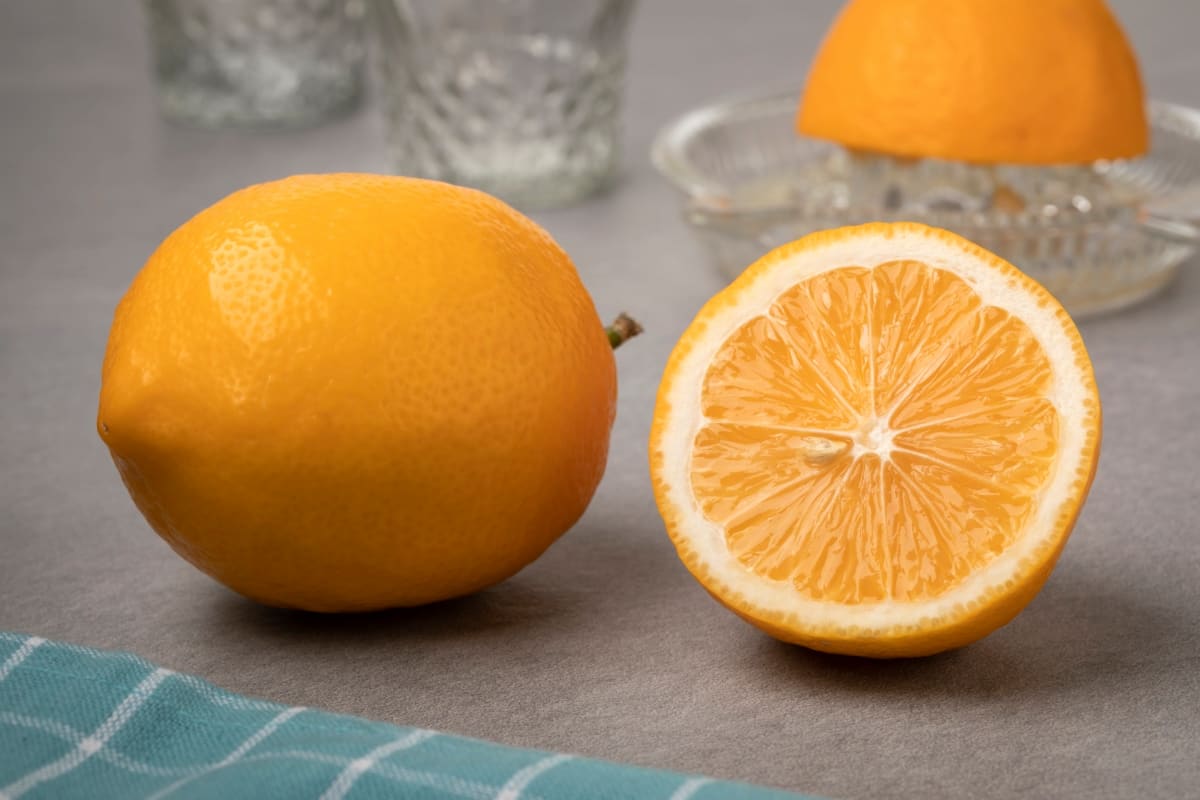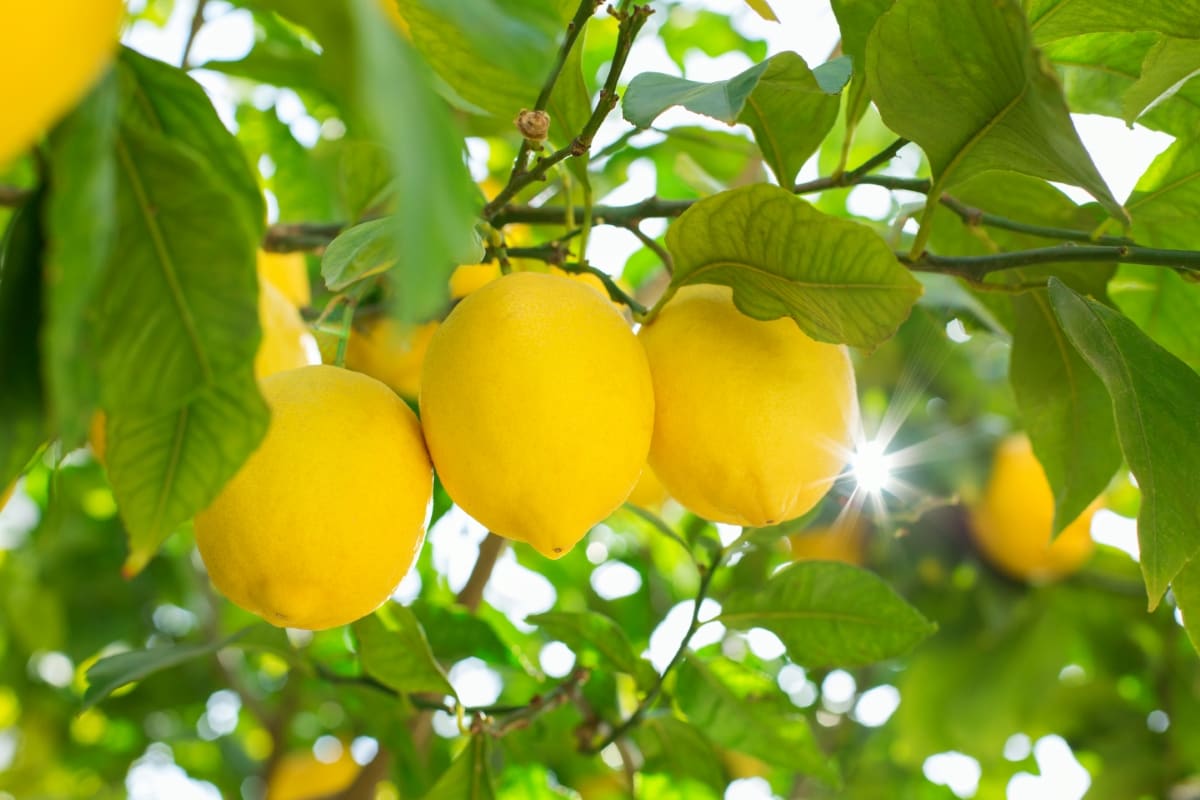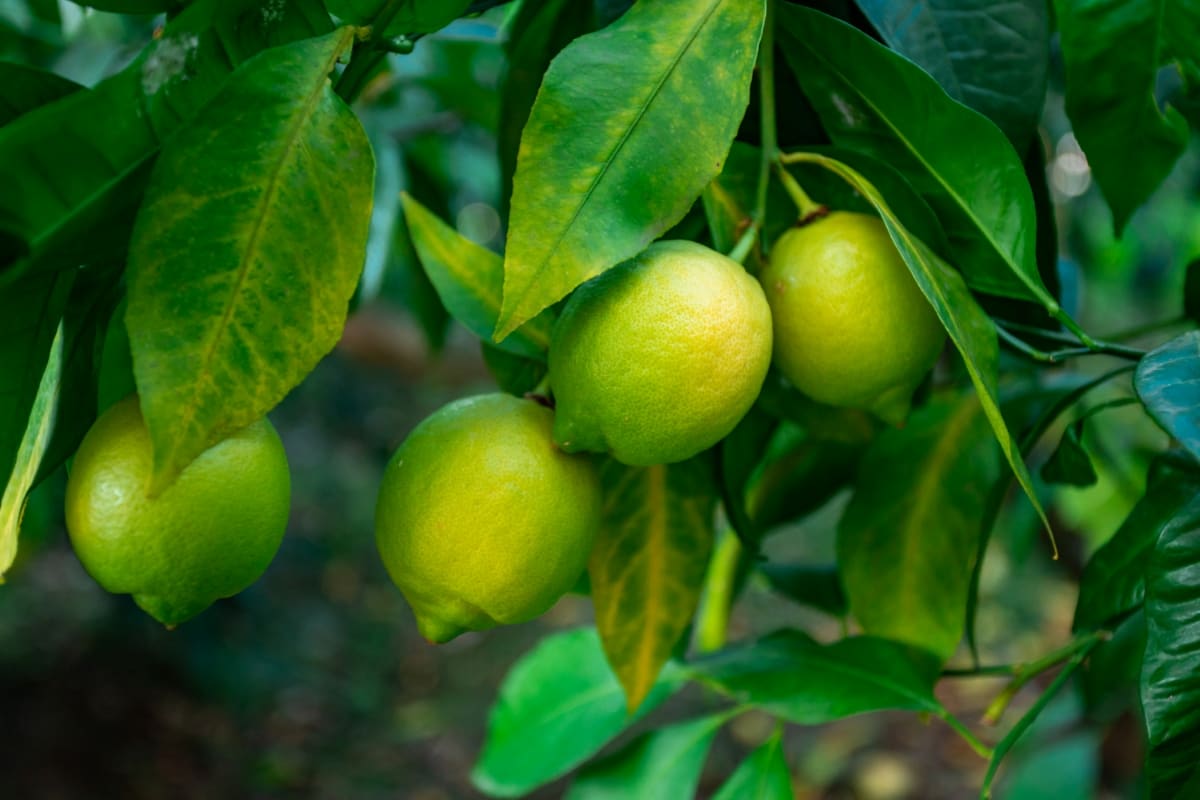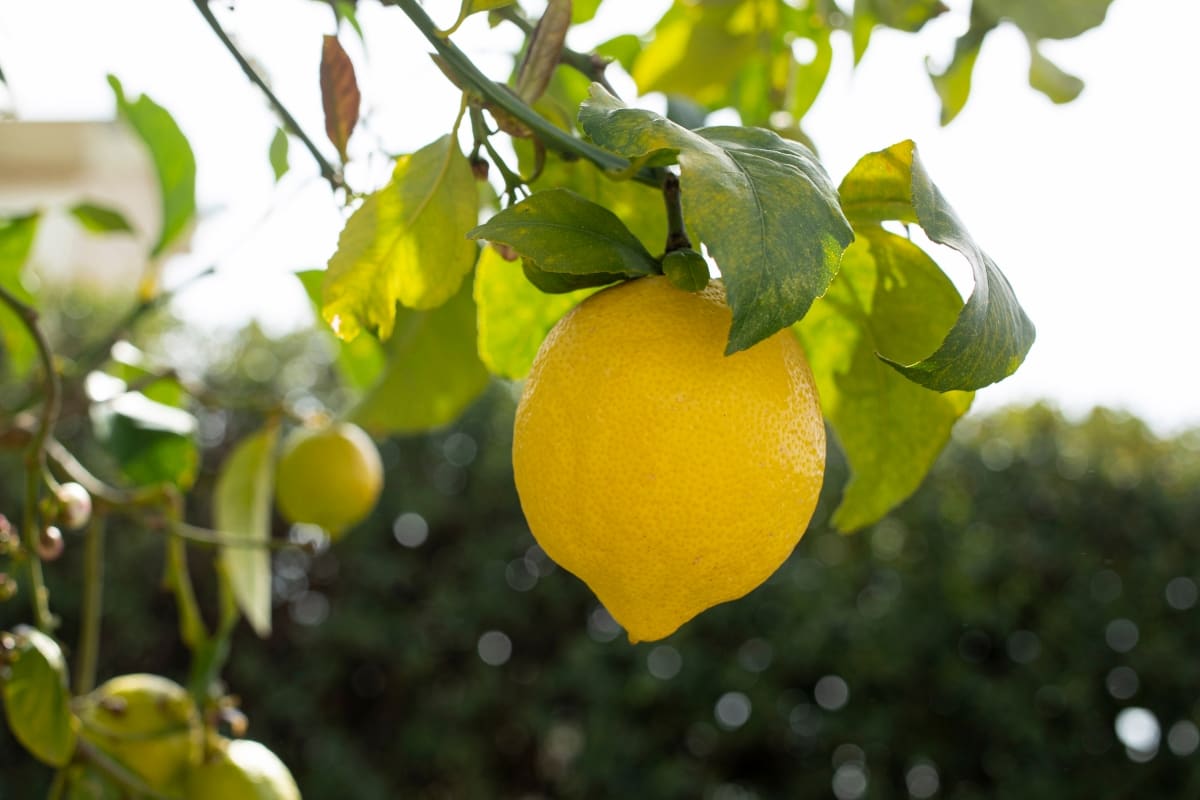A Meyer Lemon is a cross between a Lemon and a mandarin orange. Growing your food is an excellent way to promote sustainability and reduce your carbon footprint. By cultivating Meyer Lemon trees, you contribute towards local food production while minimizing transport emissions associated with store-bought Lemons.

Understanding the Meyer Lemon Tree
The Meyer Lemon tree is a fascinating plant offering beauty and delicious fruit. The Meyer Lemon tree is also known for its adaptability and ability to thrive in different growing conditions. When caring for your Meyer Lemon tree, understanding its specific needs is crucial.
This includes providing adequate sunlight, well-draining soil, and proper watering techniques. Growing a Meyer Lemon tree can be a rewarding experience. You will have access to fresh fruits throughout the year and enjoy the beauty of this evergreen citrus tree in your garden or on your patio.
What is the Difference Between a Meyer Lemon and a Regular Lemon?
Meyer Lemons are smaller and round than regular Lemons, with smoother, thin, deep yellow to orange skin and dark yellow pulp. The Meyer Lemon is sweeter than your standard Lemon, making it a delightful addition to sweet and savory dishes. Regarding appearance, Meyer Lemons have a distinct look compared to regular Lemons. They are smaller and more round, with smooth skin ranging from deep yellow to orange. This vibrant hue makes them incredibly appealing visually as well.
How to Grow Meyer Lemon Tree from Seed?
Firstly, gather fresh Meyer Lemon seeds from ripe fruit. Rinse them gently to remove any pulp or residue. Next, moisten a paper towel and place the seeds inside, folding them to create a small packet. Keep the towel damp but not soaking wet. Place the seed packet in a sealed plastic bag and then store it in a warm location, on your refrigerator, or near a sunny window. Check the moisture level regularly and mist if necessary.
After about two weeks, you should notice sprouts emerging from the seeds. Once they’re around 2-3 inches tall, carefully transplant each sprout into its small pot filled with well-draining soil mix. Provide plenty of sunlight (a south-facing window is ideal) and keep the soil moist but not waterlogged. As your seedlings grow, gradually increase their exposure to direct sunlight. Remember that Meyer Lemon growing from seed takes 4 to 6 years before your tree produces fruit. The time a Meyer Lemon Tree takes to bear fruit greatly depends on the tree’s age.
In case you missed it: How to Grow and Care for Lemon Bonsai: Planting, Pruning, and Repotting

Selecting the Ideal Location for Planting a Meyer Lemon Tree
First and foremost, these trees thrive in full sun, so finding a spot that receives 6-8 hours of direct sunlight per day is crucial. This ensures that your tree will have ample energy to produce those delicious fruits. In addition to sunlight, Meyer Lemon trees also prefer well-draining soil.
Preparing the Soil for Planting a Meyer Lemon Tree: Essential Steps
Meyer Lemon trees prefer well-draining soil with a slightly acidic pH between 5.5 and 6.5. If the soil stays wet, add some organic matter to improve drainage.
Choosing the Right Container or Planting Spot for a Meyer Lemon Tree
When selecting a container, choose one at least 18 inches in diameter and with adequate drainage holes to prevent waterlogging. This will ensure proper root development and prevent the tree from drowning. If you prefer planting your Meyer Lemon tree directly in the ground, choose a well-draining location with full sun exposure. It should be sheltered from strong winds as they can damage the delicate branches of the tree. Additionally, make sure there is enough space around it for future growth.
Step-By-Step Guide to Planting a Meyer Lemon Tree in the Ground
- Firstly, choose a sunny location for your tree. These trees thrive in full sun, so find a location that gets direct sunlight for about 6 hours each day, and it is the best place to plant a Meyer Lemon tree.
- Prepare the soil by loosening it with a garden fork or tiller.
- Dig a hole carefully twice as wide and as deep as the root ball of your tree. Carefully remove the Lemon tree from its container and place it in the hole, ensuring it sits at the same level previously planted.
- Put the soil in the hole and tamp it around the tree’s base to eliminate air pockets. Water after planting to settle the soil and ensure good root-to-soil contact.
- Mulch around the newly planted Meyer Lemon tree base with organic mulch such as wood chips or straw. This will help conserve moisture and suppress weeds. Remember to water regularly during dry periods and fertilize according to package instructions for optimal growth.
Step-By-Step Guide to Planting a Meyer Lemon Tree in a Container
- Firstly, choose a large enough container that will accommodate the growth of your Meyer Lemon tree. A pot or container with drainage holes is essential to prevent waterlogged roots. Fill the container with well-draining soil mixed with organic matter such as compost.
- Now it’s time to carefully remove your young Meyer Lemon sapling from its nursery pot. Loosen the roots if packed before placing them into the prepared container.
- Once your sapling is securely placed in its new home, add more soil around it while gently firming it down. Be careful not to compact the soil too much, which may restrict root growth.
- Water thoroughly after planting, and monitor moisture levels throughout your tree’s life. Citrus trees like consistent watering but don’t appreciate being constantly soaked or completely dried out.
- Find a sunny spot for your potted Meyer Lemon tree. Remember that containers can heat up quickly in full sun exposure, so providing some shade during hotter parts of the day might be necessary.
In case you missed it: 9 Causes of Dying Sweet Lemon Trees and How to Fix Them

Watering and Fertilizing Techniques for a Thriving Meyer Lemon Tree
Proper watering techniques will ensure that your tree receives adequate moisture without being overwatered, which can lead to root rot, and it is important to water deeply. The main factor is insufficient sunlight, inadequate watering practices, and nutrient deficiencies are the main reasons for Meyer Lemons not turning yellow.
Use a citrus-specific fertilizer with a balanced ratio of N, P, and K. Apply fertilizer according to package instructions during the season for Meyer Lemons, usually from spring through fall. Remember that organic options such as compost or well-rotted manure can be used instead of chemical fertilizers.
Pruning and Training a Meyer Lemon Tree: Best Practices
When it comes to pruning, remove any dead or damaged branches. This will prevent the plant disease from spreading and encourage new growth. Make clean cuts above a bud or leaf node. Training your Meyer Lemon tree involves shaping it into a desirable form. Prune back long shoots annually in early spring to maintain a compact size for container-grown trees. This will help control their height and width while promoting fruit production.
Protecting Your Meyer Lemon Tree from Pests and Diseases
Look for any signs of trouble, such as discolored leaves, wilting foliage, or unusual growths. This will allow you to identify Meyer Lemon tree problems early on and take appropriate action. To prevent common pests in the Meyer Lemon tree, like aphids or scale insects, from infesting your Meyer Lemon tree, consider using natural remedies like neem oil spray or insecticidal soap. These organic solutions are safe for the environment and your tree while effectively controlling unwanted critters.
In case you missed it: How to Treat Brown Spots on Lemon Tree Leaves Naturally: Causes, Fix With Effective Organic Home Remedies

In addition to pests, diseases can also threaten your beloved citrus plant. Citrus bacterial blast, citrus greening disease, and brown rot are just some diseases that may affect your Meyer Lemon tree. To minimize the risk of infection, ensure proper sanitation practices by regularly cleaning fallen fruit and debris around the tree’s base. Remember that prevention is always better than cure when protecting your Meyer Lemon tree from pests and diseases.
Number of Lemons a Meyer Lemon Tree Produce and Tree Height, and Size
Standard Meyer Lemon tree height typically grows 6-10 feet tall, while the dwarf variety is shorter at 5-7 feet. But regardless of Meyer Lemon tree size, both types can impress you with their productivity. At full maturity, just one Meyer Lemon tree has the potential to bear around 1000 fruits in a single year.
Brief Profile of Meyer Lemon Tree
| Hardiness Zones | 8 – 11 |
| Reaching Height | Regular: 6 to 10 feet tall, Dwarf: 5 to 7 feet tall |
| Sunlight | Minimum 8 hours of Direct Sunlight |
| Soil Recommended | Well drained with a pH value of 5.5 to 6.5 |
| Lifespan | Approximately 50 years |
| Appearance of flowers and fruits | White blossoms, Yellow-orange fruits |
| Optimal Temperature | 50 to 80ºF |
| Pollination | Self-Pollinating |
| Time takes to bear a fruit | Grafted – 2 years |
| Harvesting season | Heavy in Winter |
| Suitable location | Outdoors and Indoors |
Conclusion
You can easily grow your very own Meyer Lemon tree right at home. Taking care of your Meyer Lemon tree is essential to ensure its growth and productivity. These citrus trees require specific attention to thrive and produce delicious fruits. You can enjoy a bountiful harvest from Meyer Lemon tree year after year by providing proper Meyer Lemon tree care.
- Feed Your Flock for Less: Top 10 Tips to Save on Chicken Feed
- Ultimate Guide to Ossabaw Island Hog: Breeding, Raising, Diet, and Care
- Hatching Answers: The Top 10 Reasons Your Chickens Aren’t Laying Eggs
- Eggs and Economics: Breaking Down the Cost of Raising Backyard Chickens
- Defend Your Greens: Proven Methods to Keep Iguanas Out of Your Garden
- Ultimate Guide to Cinnamon Queen Chicken: A Comprehensive Guide for Beginners
- Ultimate Guide to California Tan Chicken: Breeding, Raising, Diet, Egg-Production and Care
- Ultimate Guide to Marsh Daisy Chicken: Breeding, Raising, Diet, and Care
- 10 Types of Chicken Farming Businesses You Can Start for Profits